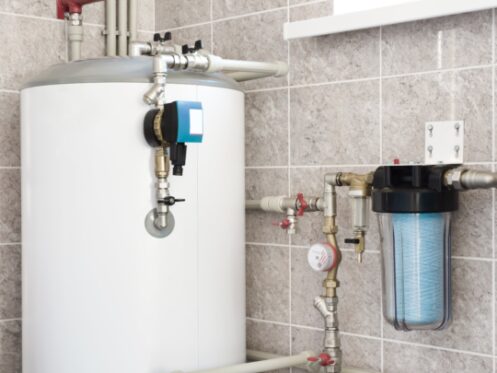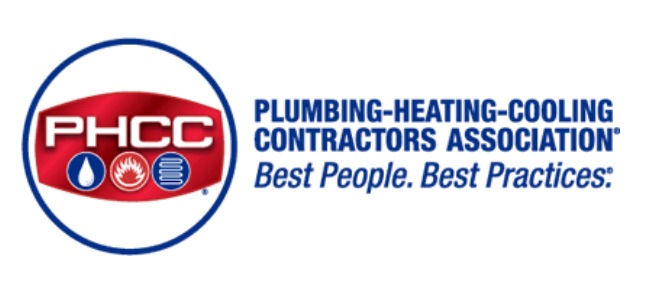Having your water heater set to the correct temperature is always important. If you have a tank water heater and the temperature is too low, it could lead to issues with bacteria growing. Setting the temperature too high is also an issue as it creates a risk of scalding and also increases how much energy your water heater uses. Adjusting the temperature on a water heater is a relatively simple task, and here are the steps involved for the most common types of water heaters.
Temperature Adjustments on a Gas Tank Water Heater
If you have a gas tank water heater, the temperature control will be located near the bottom of the unit. The control knob is usually located on the side of the tank, but it may also be hidden inside a small access panel. To change the temperature, all you need to do is turn the knob. Turning the knob clockwise will raise the temperature, and counterclockwise lowers the temperature.
The only problem is that most units don’t actually show what temperature each of the different settings corresponds to. Instead, most water heaters have numbers, letters, or symbols that mark each setting, and these can differ based on the manufacturer. Still, once you know what temperature each setting corresponds to, then raising or lowering the temperature is a cinch.
The setting furthest to the left should be the “Off” setting, and this is usually followed by either a circle or a setting labeled “Low.” The “Low” setting should never be used as it is typically only 100 degrees Fahrenheit, which isn’t hot enough to prevent bacteria from growing. The next setting is usually marked with a triangle or labeled “Hot,” and this is the lowest setting you should ever use. The “Hot” setting should be 120 degrees, and the next three settings will be for 130, 140 and 150 degrees. Finally, the setting furthest to the right is 160 degrees, and this setting is usually labeled “Very Hot.”
Depending on the model and age of your water heater, there may also be two additional settings. If your unit has a standing pilot light, you will see a setting labeled “Pilot” just after the “Off” setting. To relight the pilot light, you need to turn the knob to the “Pilot” setting and then press and hold it in. While keeping the knob pressed in, you then need to press the electronic igniter button a few times until you see that the pilot is lit. Once it is lit, you need to continue to hold the knob in for around 30 seconds or else the pilot will go out again. After 30 seconds, you can then turn the knob to the desired setting.
Some units with a pilot light will also have a “Vacation” setting. When set to “Vacation” mode, the unit won’t ever turn on and heat so that it doesn’t waste energy while you’re away. However, a small amount of gas will continue to flow in order to keep the pilot light lit so that you don’t have to relight it when you get back home. Nonetheless, if you’re going to be gone for more than a few days, it is usually best to simply turn the unit completely off and then relight the pilot once you get back.
Changing the Temperature on an Electric Tank Unit
If you have an electric tank water heater, the temperature control will be inside an access panel somewhere at the base of the unit. The cover to this panel is typically secured with a couple of screws that you will need to remove. Once the cover is off, you will also usually have to pull out a small piece of insulation to get to the temperature control knob.
As with gas units, the different settings are typically marked with symbols and numbers or letters. Each setting should correspond to the same temperature as on a gas unit. Once you’ve adjusted the unit to the desired setting, you then want to make sure to replace the insulation and put the cover back on the access panel.
Tankless Water Heater Temperature Control
Tankless water heaters are superior to tank units in a number of different ways. Either an electric or a gas tankless water heater will be much more efficient and use less energy. Another advantage is that adjusting the temperature is much more straightforward. This is because tankless water heaters often have a digital display similar to a thermostat. In this case, all you need to do is push the up or down arrow until the display reads your desired temperature.
Some tankless water heaters do still use a knob for adjusting the temperature. In this case, the lowest setting will still typically be 120 degrees Fahrenheit and the highest setting will be around 160 degrees.
What Temperature Should a Water Heater Be Set To?
Exactly how hot your water should be is mostly a matter of personal preference. Again, you still always want to leave the unit set to at least 120 degrees to prevent bacteria from potentially growing inside the tank. If the temperature is ever below 120 degrees, it could lead to problems with Legionella, which is the bacteria that causes Legionnaire’s disease.
If you have younger children in the home, you’re usually best off leaving the temperature at 120 or 130 degrees since anything higher could create a scalding risk. The U.S. Department of Energy always recommends leaving your water heater at 120 degrees so that the unit uses less energy. However, OSHA instead recommends setting the temperature to 140 degrees as this will be more effective for cleaning and sanitizing.
If you only have the temperature set to 120 or 130 degrees, it is usually a good idea to turn the unit up to the next highest setting during the winter and then back down in the spring. This is because the water coming into the unit will always be colder in the winter, which can lead to the unit taking much longer to heat if you don’t turn the temperature up.
Generally speaking, 140 degrees is really the highest you should ever go. If the water is any hotter, it could easily scald you. However, there are a few very specific situations where you may want to temporarily turn the temperature all the way up to 160 degrees Fahrenheit for a few hours.
If your hot water suddenly starts smelling bad, it could mean that there are bacteria in the tank. In this case, turning the temperature all the way up for a few hours should work to kill any bacteria that are present. After letting the unit sit for a few hours to make sure it fully heats the water to 160 degrees, you can then turn the unit back down to your preferred setting.
The other time that we would recommend doing this is if your water heater is ever off for more than a day. In this case, the water could cool enough that bacteria can start to form, so it’s a good idea to crank the temperature all the way up for a bit just to be safe.
Our team at Meade’s Heating and Air can help if you’re having any issues adjusting your water temperature or you find your water doesn’t get hot enough. We specialize in water heater repairs, installation, and maintenance as well as all types of heating, cooling, and indoor air quality services. If you’d like to obtain more information or schedule a service call anywhere in the Sterling area, contact us today.




